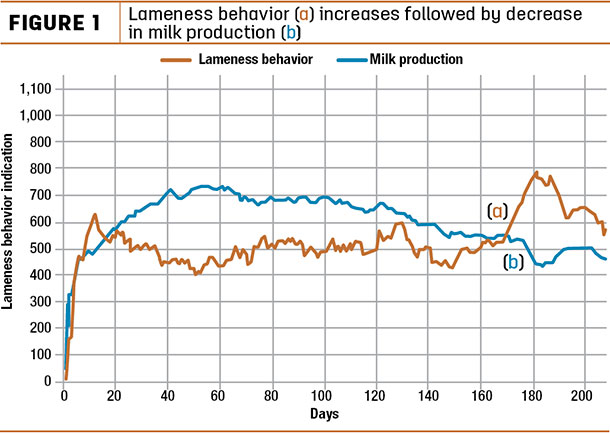Lameness is one of the most common and most economically destructive production diseases of dairy cows. It is associated with a reduction in milk yield and fertility and an increase in culling rate and medical costs.
The prevalence of lameness in dairy cow herds is estimated within the range of 20 to 25 percent, but it could reach up to 80 percent in some herds.
Early detection is a key factor in reducing the negative impact of lameness. Lame cows spend more time lying and have longer durations of lying bouts. Hence, the use of automatic monitoring systems for detecting lame cows could improve the detection and allow earlier treatment of those cows.
A field study to test the performance of an automatic behavior system in detecting lame cows was conducted during the fourth quarter of 2012 on a Spanish dairy herd. Pedometers measuring cows’ activity (steps) and rest behavior (rest time and rest bout) were fitted on 651 out of the 1,568 milking cows in the herd.
Weekly lists of cows suspected for lameness, based on the recorded lying data, were created (Figure 1). These cows were scored in the same week for locomotion score (LS) and scaled at a rating of 1 to 5 (1 sound, 5 severe lame) by the herd’s staff.

In addition, any lame cow or cow with hoof damage observed by staff during that week was recorded and considered a “lame cow.” Every “suspected” cow found with LS of 2 or higher was removed from the subsequent weeks of the study.
Cows detected as lame by the system were classified as true positive if they were found with LS 2 or greater and false positive if LS was 1. Cows that were scored LS 2 or higher by the farm staff and were not detected by the system were classified false negative.
The rest of the cows that were not detected by the system or the farm staff as lame cows were classified as true negative. The performance of the system, sensitivity (detection rate), specificity and accuracy for detecting lame cows with LS 2, LS 3 or greater were evaluated.
Out of the 651 cows fitted with pedometers, 73 (11.2 percent) cows were observed LS 2, and 81 (12.4 percent) were observed LS 3 or higher. The performance of the system for detecting cows with LS 2 or higher is summarized in Table 1. Overall, the sensitivity and specificity for LS 2 or higher were 74.8 percent and 91.7 percent, respectively.

The sensitivity for first-lactation cows was higher than that of second-lactation and mature cows, while no difference was found for specificity.
The sensitivity and specificity for LS 3 or higher were 60 percent and 94.4 percent, respectively. This was the same trend as for cows observed with LS 2 or greater, with higher sensitivity for first-lactation cows compared with second-lactation and mature cows, and no difference of specificity among the three groups.
The sensitivity and specificity for detecting lame cows for the entire study period (not by week) were 91.6 percent, 86.1 percent and 94.2 percent, 82.2 percent for cows with LS 2 and LS 3, respectively.
When comparing the prevalence of the reported LS 3 or greater cows among the 651 cows monitored in the study with the 917 cows that were not monitored by the system, detection was almost double for cows monitored by the system: 12.4 percent versus 6.7 percent.
The performance obtained by the system for both cows with LS 2 and LS 3 or greater were moderate sensitivity for second-lactation and mature cows and high for first-lactation cows. High specificity was obtained for the three groups. These results indicate that lameness could be detected by the automatic monitoring system.
The study demonstrated the capability of the system to detect cows with LS 2. This allows the detection of lame cows at a very early stage of the disease, which could lead to early veterinary intervention and faster recovery.
Comparing the two populations in the farm (ones measured by the system versus ones only observed by the farm team) indicates the advantage of the system in detecting cows with moderate to severe lameness as well.
The results demonstrate that an automated cow monitoring system measuring activity and lying behavior could be valuable for detecting lameness events in dairy cows. This type of cow monitoring system would assist in reducing production losses and treatment cost as well as improving cows’ reproduction, longevity and welfare.









